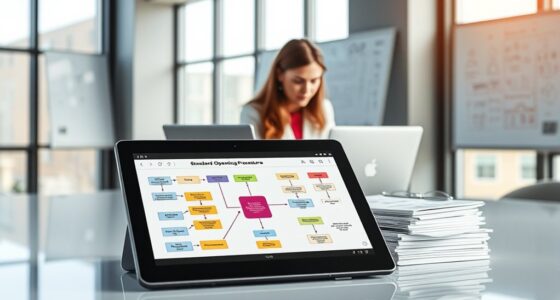To slash energy costs in your QA lab and be more climate-friendly, start with energy audits to pinpoint wasteful areas. Upgrade to energy-efficient lighting, HVAC, and equipment, and schedule heavy tasks during off-peak hours. Consider installing solar panels or wind turbines if feasible, and leverage regional incentives. These strategies not only lower expenses but also boost your environmental responsibility—discover additional steps you can take to maximize savings and prepare for a greener future.
Key Takeaways
- Conduct energy audits to identify inefficiencies and target improvements.
- Upgrade to energy-efficient lighting, HVAC, and lab equipment to reduce consumption.
- Incorporate renewable energy sources like solar panels and wind turbines for on-site power.
- Schedule equipment use during off-peak hours to minimize demand charges.
- Leverage regional incentives and grants to offset renewable energy installation costs.

Have you ever wondered how quality assurance labs can reduce their environmental impact? The answer lies in adopting sustainable practices that not only benefit the planet but also substantially cut energy costs. By shifting towards renewable energy integration, labs can harness cleaner, more efficient power sources, reducing reliance on traditional fossil fuels that often drive up expenses and contribute to pollution. Solar panels and wind turbines are becoming common fixtures, allowing labs to generate their own energy and lower monthly utility bills. This shift isn’t just about environmental responsibility; it’s a strategic move to improve operational efficiency and long-term savings.
Implementing sustainable practices starts with energy audits that identify waste and inefficiencies within lab operations. Once you understand where energy is being wasted, you can make targeted improvements—such as upgrading to energy-efficient lighting, HVAC systems, and laboratory equipment. These upgrades reduce overall energy consumption and decrease operational costs. For example, LED lighting and high-efficiency HVAC units consume far less power, directly translating into lower energy bills. Additionally, scheduling equipment use during off-peak hours can minimize demand charges, further reducing costs. These small, strategic adjustments compound over time, delivering substantial savings.
Start with energy audits to identify waste and optimize efficiency through upgrades and smarter scheduling for significant savings.
Renewable energy integration is perhaps the most impactful way to slash energy costs. Installing solar panels on lab rooftops or using wind energy where feasible allows your facility to produce its own power. Many regions offer incentives and grants for renewable energy projects, which can offset initial installation costs. Over time, the savings on energy bills outweigh the upfront investment, making renewable energy a financially sound choice. Plus, these systems provide a hedge against fluctuating energy prices, offering stability and predictability for your budget.
Beyond cost savings, renewable energy and sustainable practices enhance your lab’s reputation and compliance with environmental standards. Many clients and partners prioritize working with environmentally conscious organizations, and showcasing your commitment to green initiatives can strengthen your market position. Additionally, reducing your carbon footprint aligns with global efforts to combat climate change, giving you a sense of purpose and leadership in your industry.
Incorporating sustainable practices and renewable energy integration into your QA lab isn’t just good for the environment—it’s a wise financial decision. By making these changes, you can lower energy costs, boost operational efficiency, and demonstrate your commitment to sustainability. Implementing energy-efficient technologies and appropriate technology choices can further optimize your energy use and maximize savings. It’s a win-win situation that ensures your lab remains competitive, responsible, and prepared for a greener future, all while saving money in the process.
Frequently Asked Questions
What Specific Renewable Energy Sources Do These Labs Utilize?
You might wonder what renewable energy sources these labs use. They typically harness solar panels to generate clean electricity during sunny days and wind turbines to produce power when the wind blows. These sustainable options help reduce reliance on fossil fuels, lowering energy costs and carbon footprints. By integrating solar and wind energy, the labs create a more eco-friendly environment while maintaining efficient operations.
How Do Climate-Friendly Practices Affect Testing Accuracy?
Climate-friendly practices enhance sustainable testing and eco-friendly validation by creating a stable environment that minimizes disruptions. When labs adopt energy-efficient technologies and eco-conscious procedures, you benefit from consistent test results and improved accuracy. These practices reduce external influences like temperature fluctuations and energy variability, ensuring your testing process remains reliable. Embracing such practices not only helps the planet but also boosts the precision and trustworthiness of your testing outcomes.
What Are the Initial Costs of Implementing Green Technologies?
Imagine upgrading your lab with solar panels and energy-efficient systems—initial costs can seem steep. A thorough cost analysis helps you understand expenses involved in technology integration, like equipment upgrades and infrastructure. While upfront investments may be high, long-term savings and environmental benefits often outweigh initial costs. For example, a case study shows that early green tech investments lead to significant energy savings and lower operational expenses over time.
How Do These Labs Measure Their Carbon Footprint Reduction?
You can measure your lab’s carbon footprint reduction by tracking energy consumption and comparing it over time. Incorporate carbon offsetting strategies, like investing in renewable energy projects, to further lower your impact. Use sustainable materials in your lab’s operations and equipment, and regularly review your progress. This ongoing measurement helps you see how green initiatives, such as efficient lighting and waste reduction, effectively decrease your carbon footprint.
Are There Industry Standards Supporting Climate-Friendly QA Lab Designs?
You’ll find that industry standards like Laboratory certification and Green certification support climate-friendly QA lab designs. These certifications set benchmarks for sustainable practices, energy efficiency, and eco-conscious materials. Achieving such certifications not only validates your lab’s commitment to environmental responsibility but also helps you follow best practices, reduce costs, and demonstrate your leadership in sustainable laboratory operations. Adhering to these standards guarantees your lab aligns with industry expectations for climate friendliness.
Conclusion
By adopting climate-friendly practices, you reduce energy use, lower costs, and protect the environment. You create a space that’s efficient, sustainable, and responsible. You embrace innovation, cut waste, and inspire change. You build a future where quality testing is smart, green, and cost-effective. Together, these efforts shape a world where your QA lab thrives while safeguarding the planet. Your choices matter—make them count, and lead the way toward a greener tomorrow.









